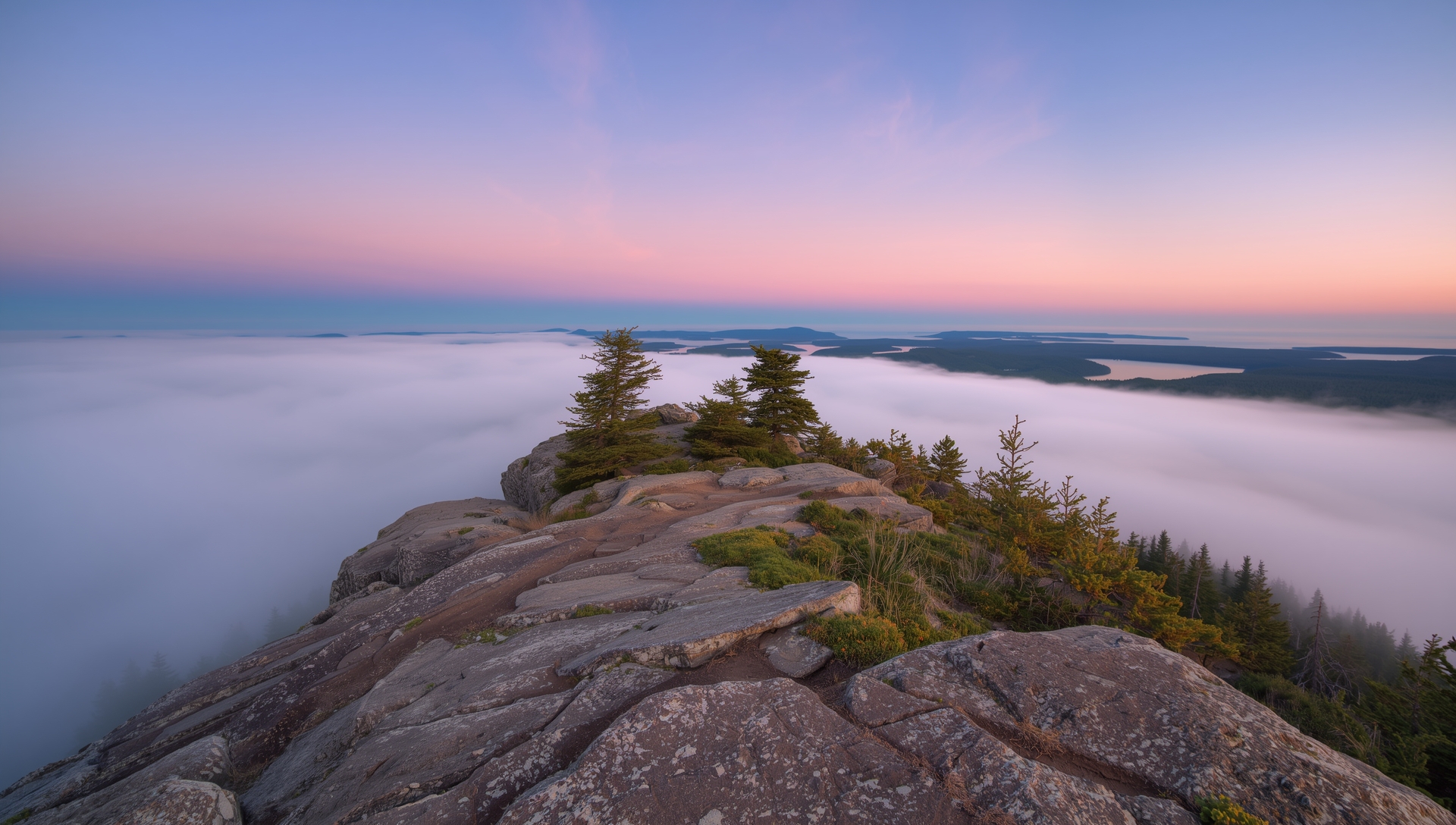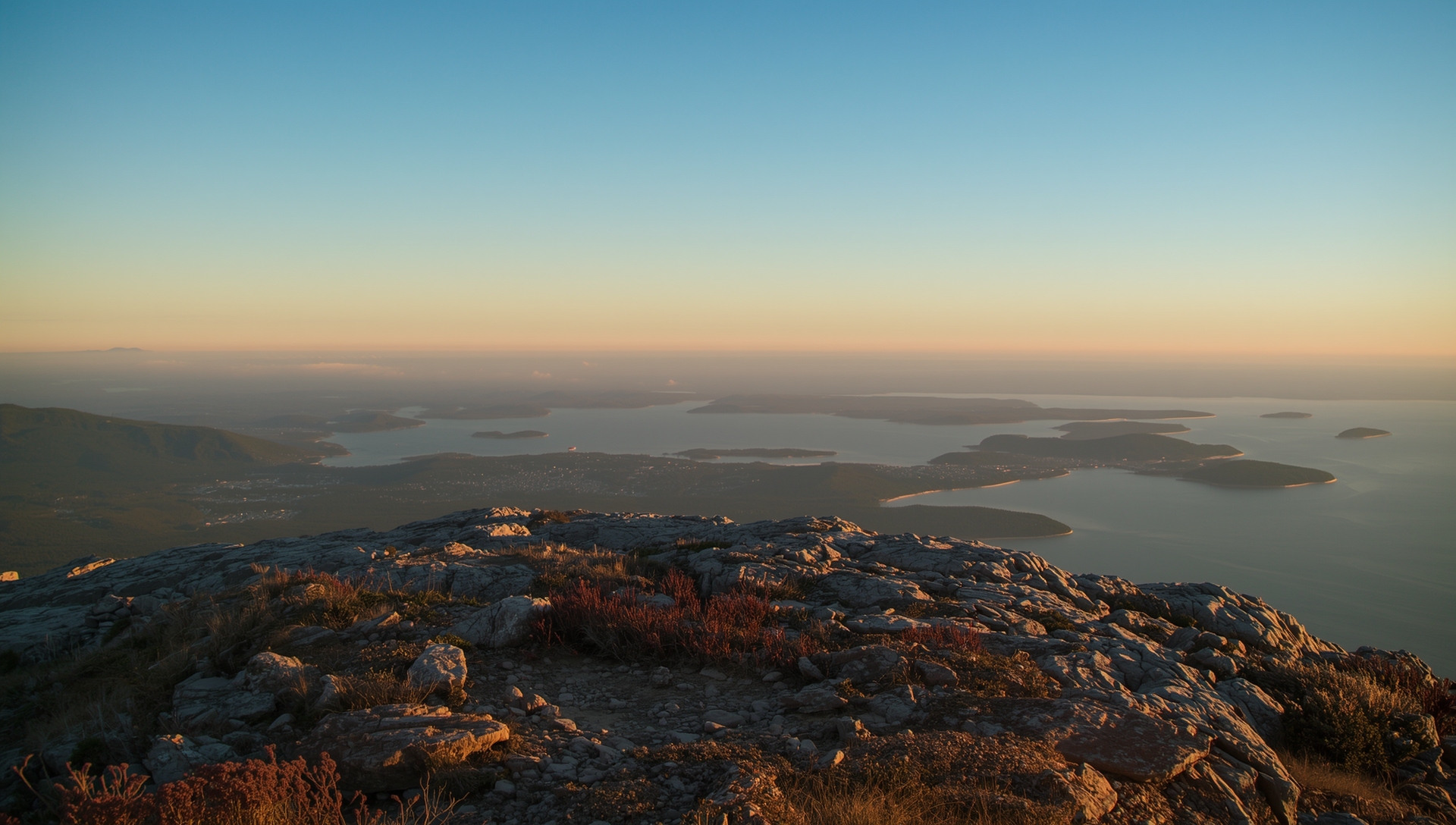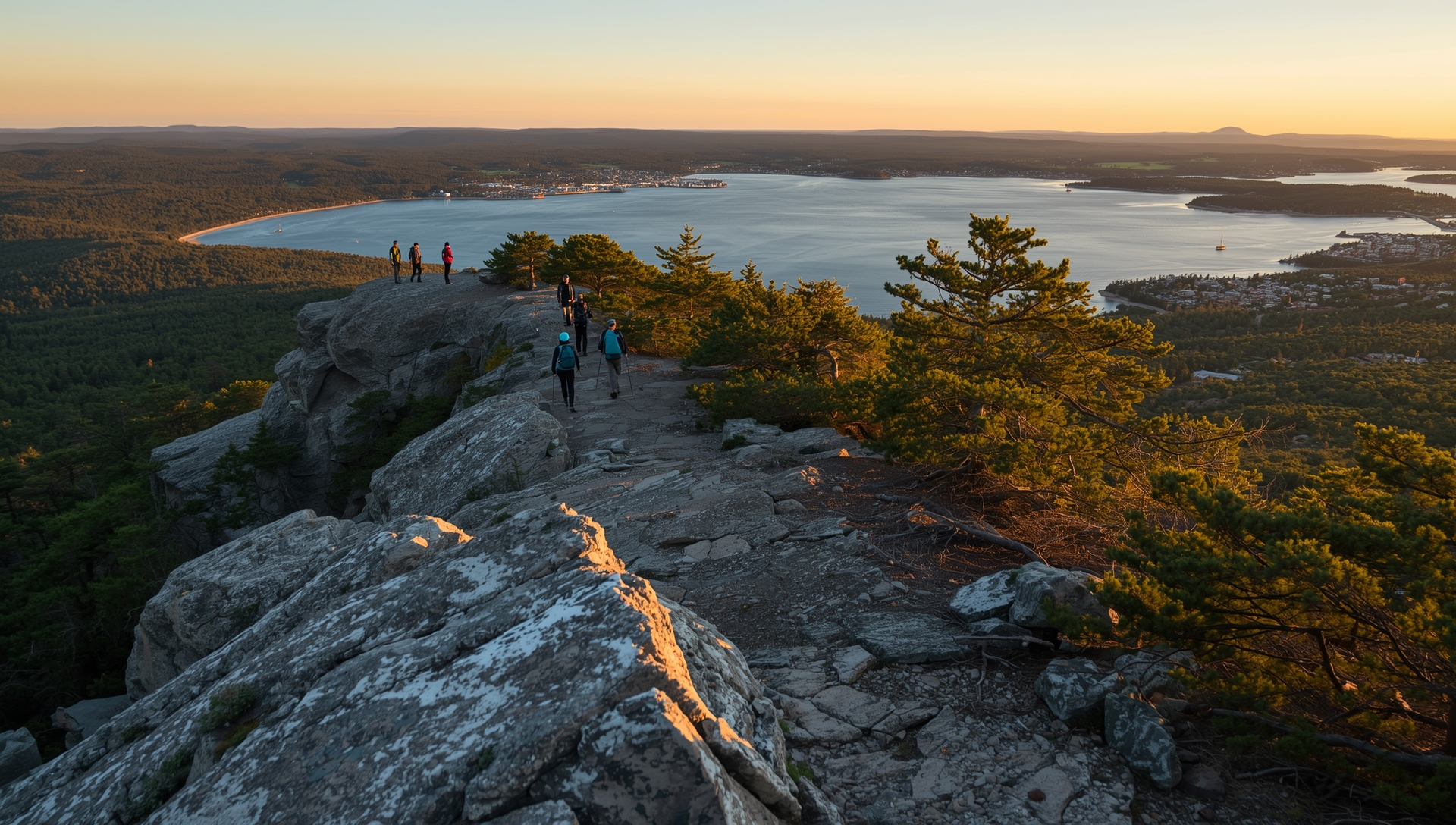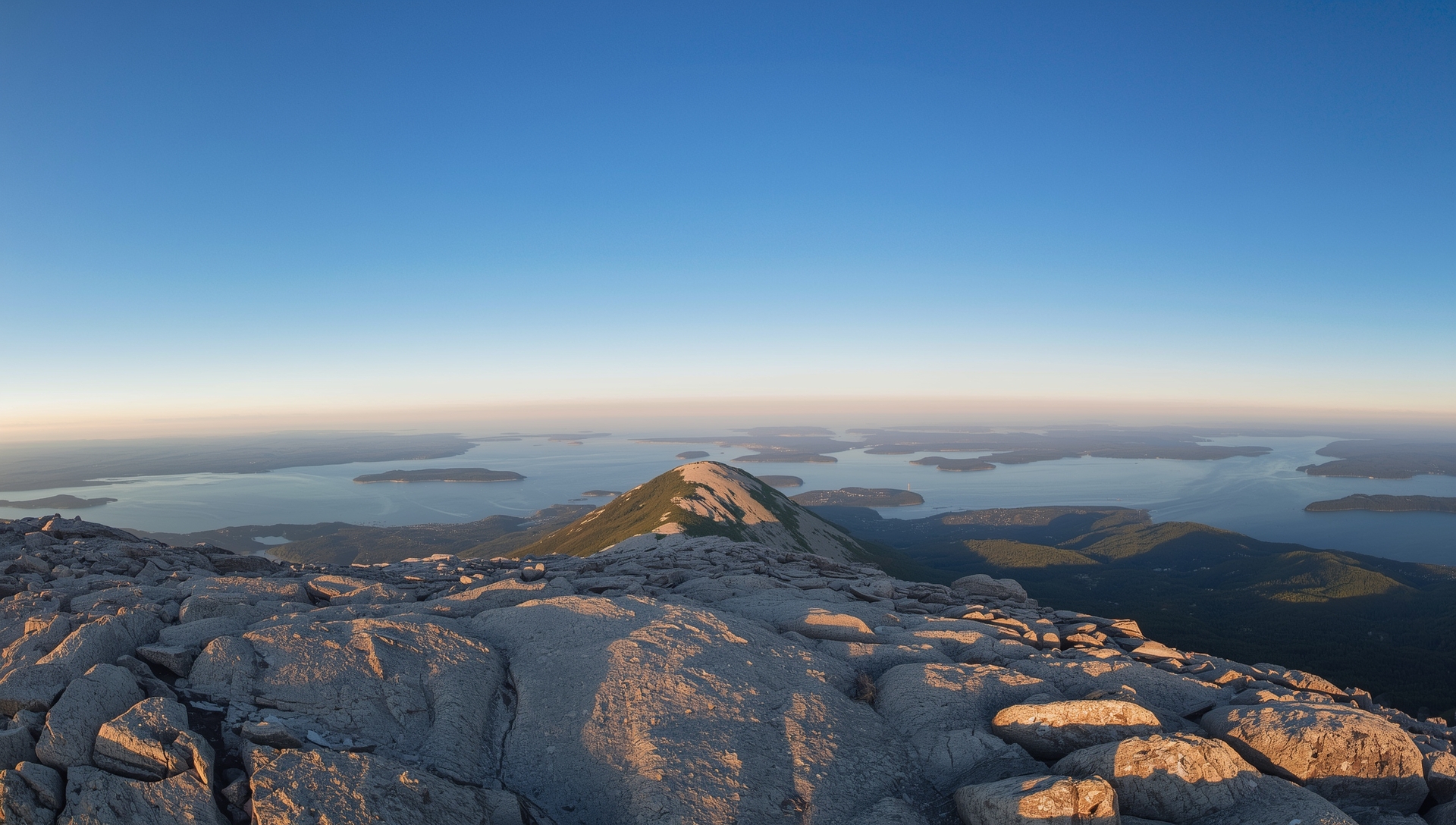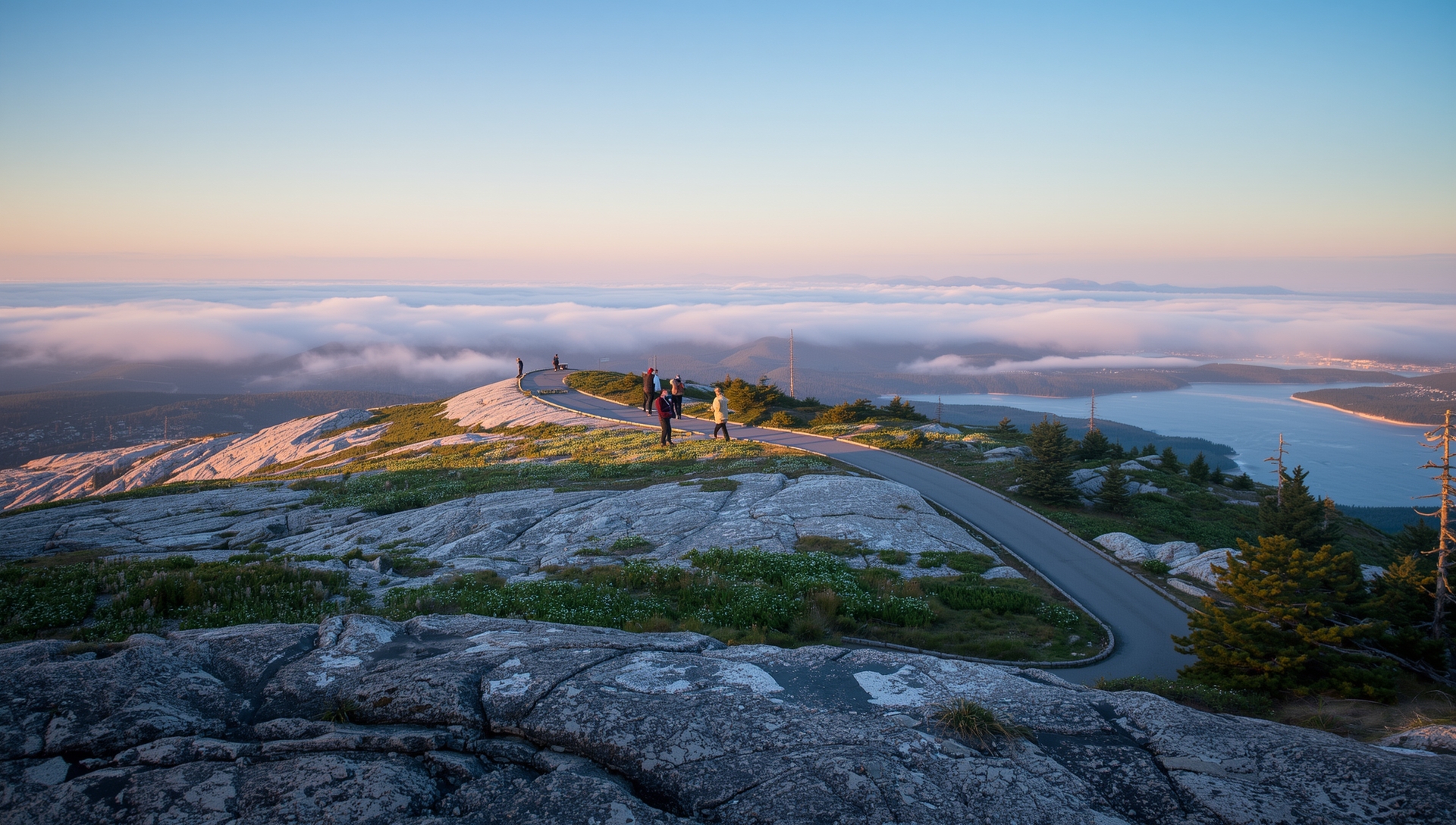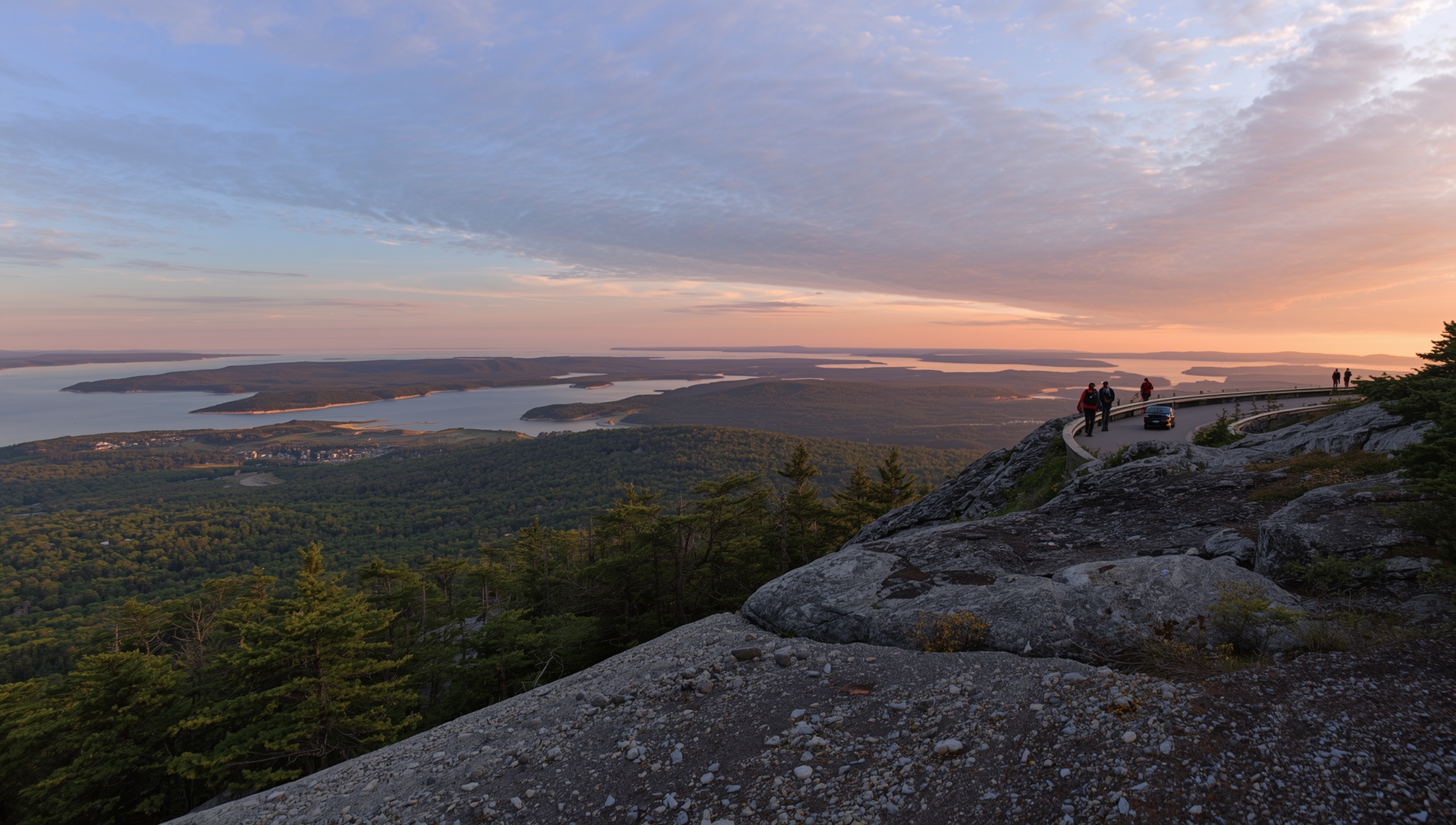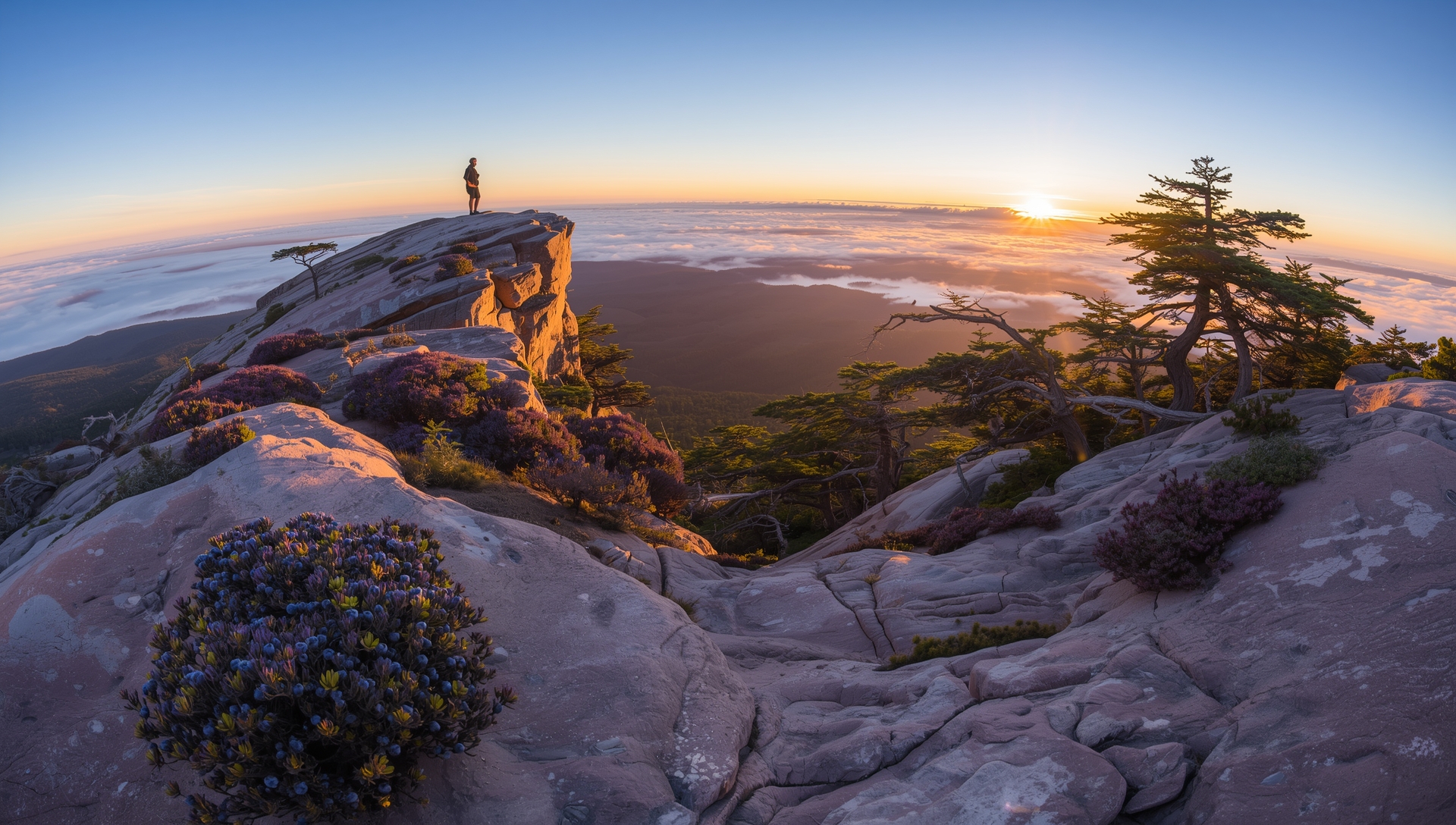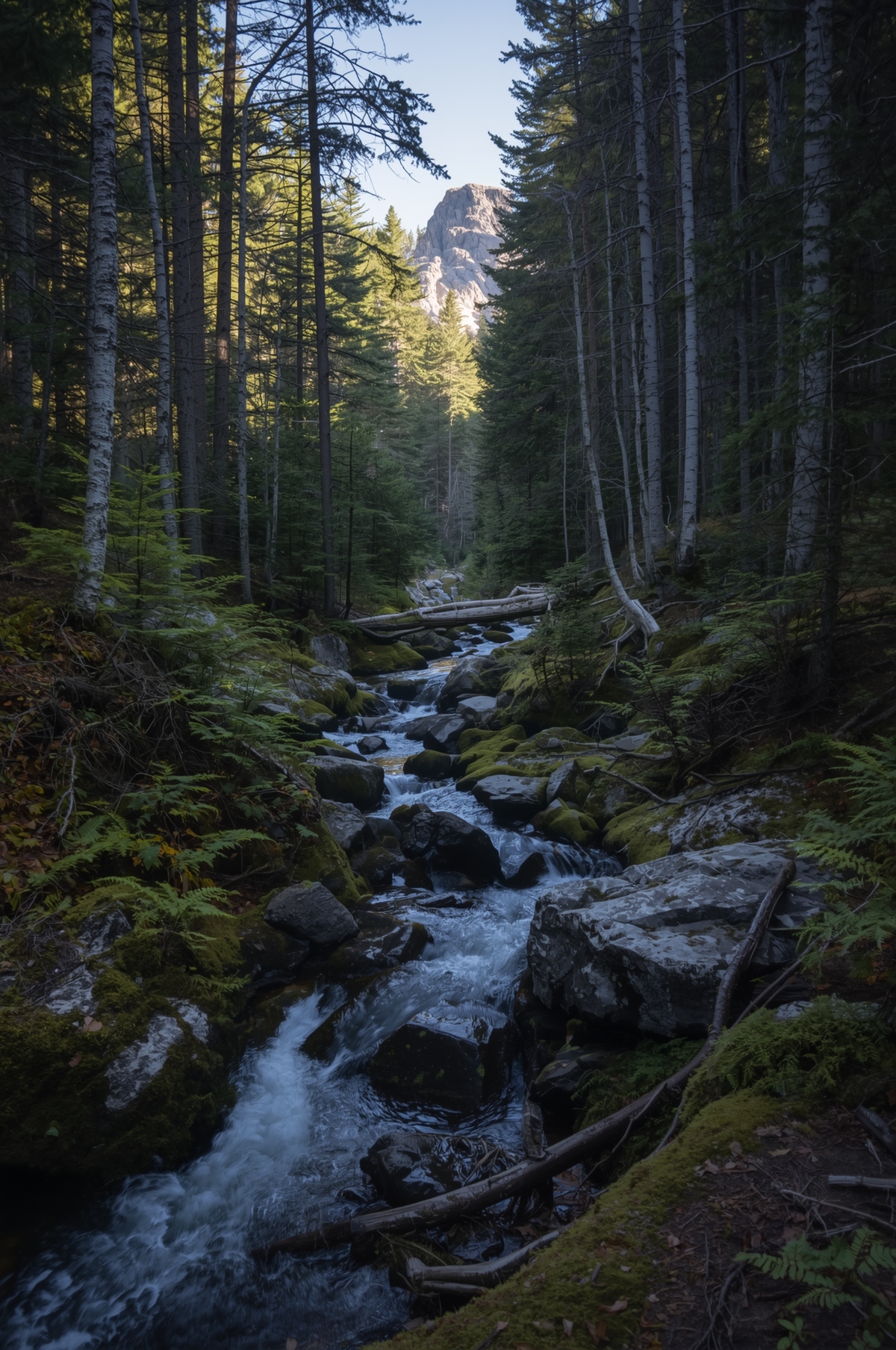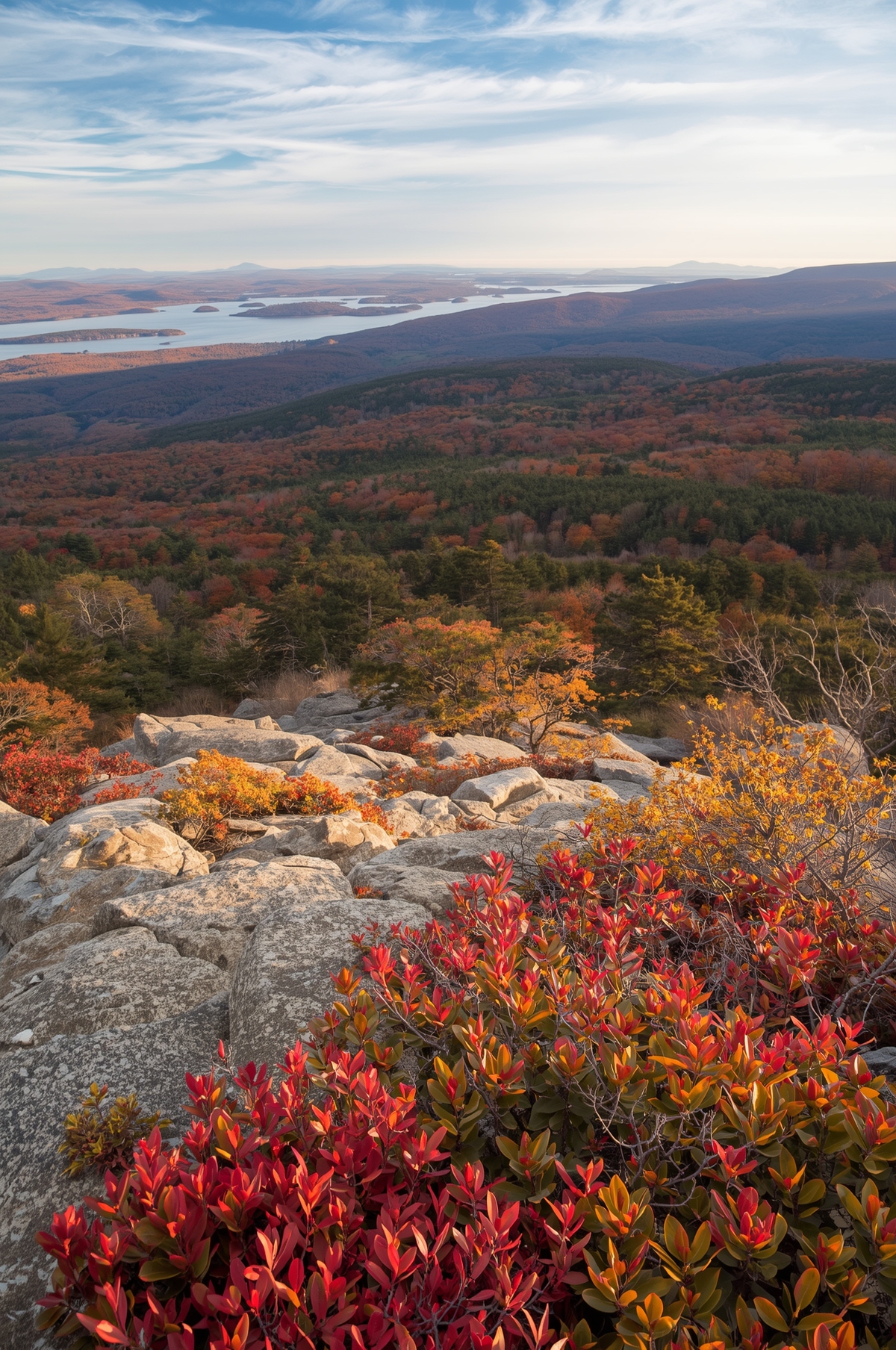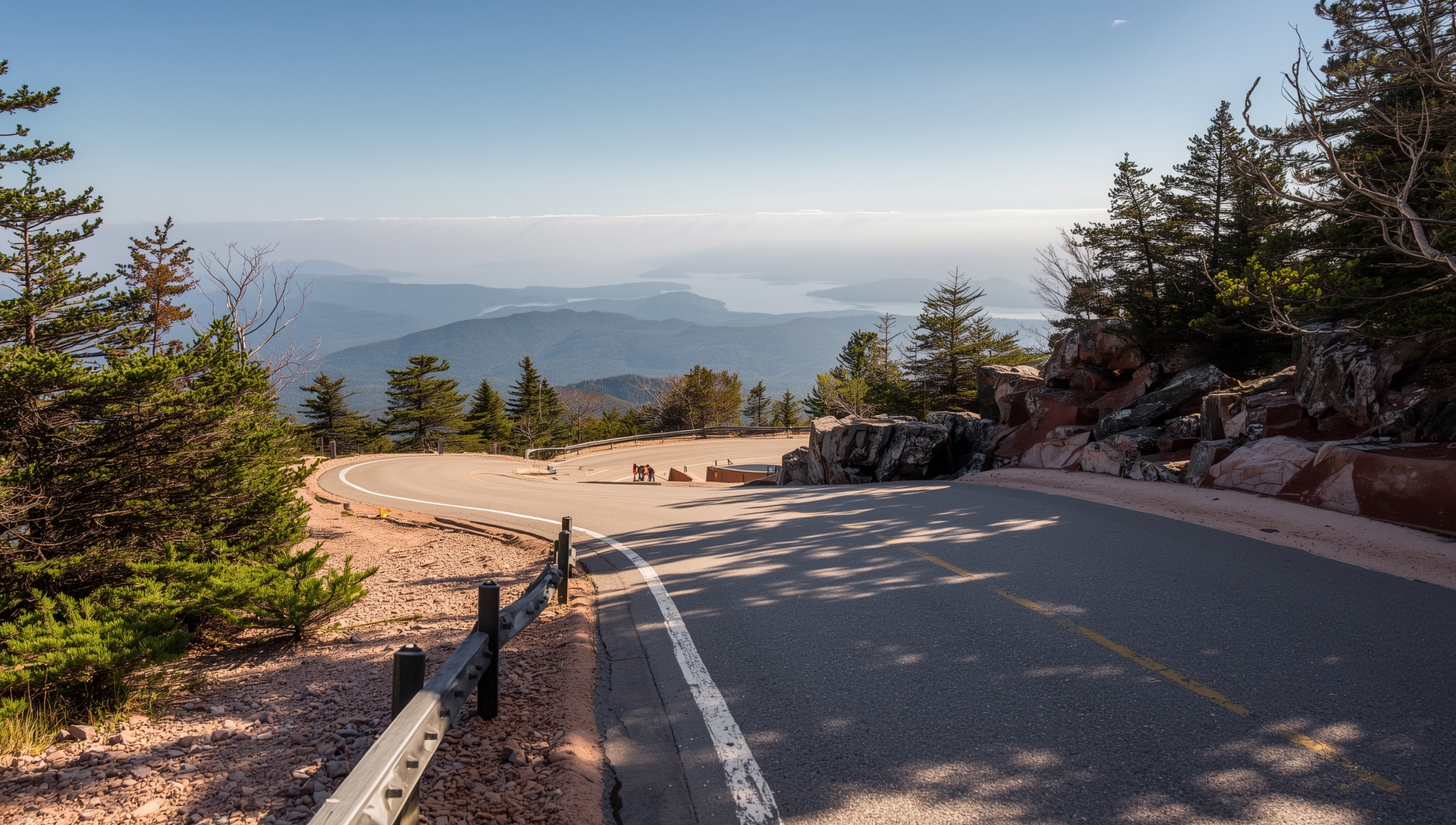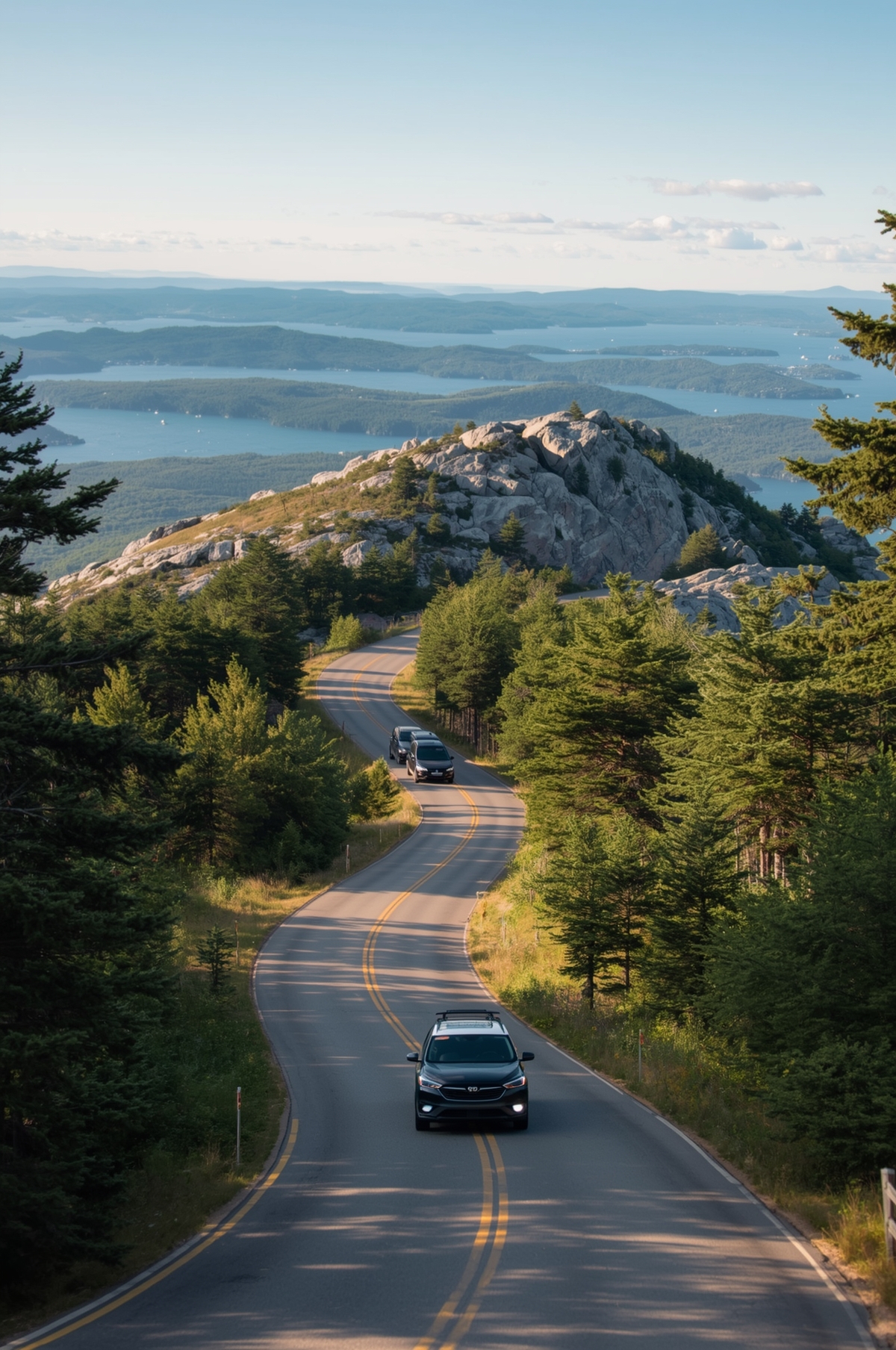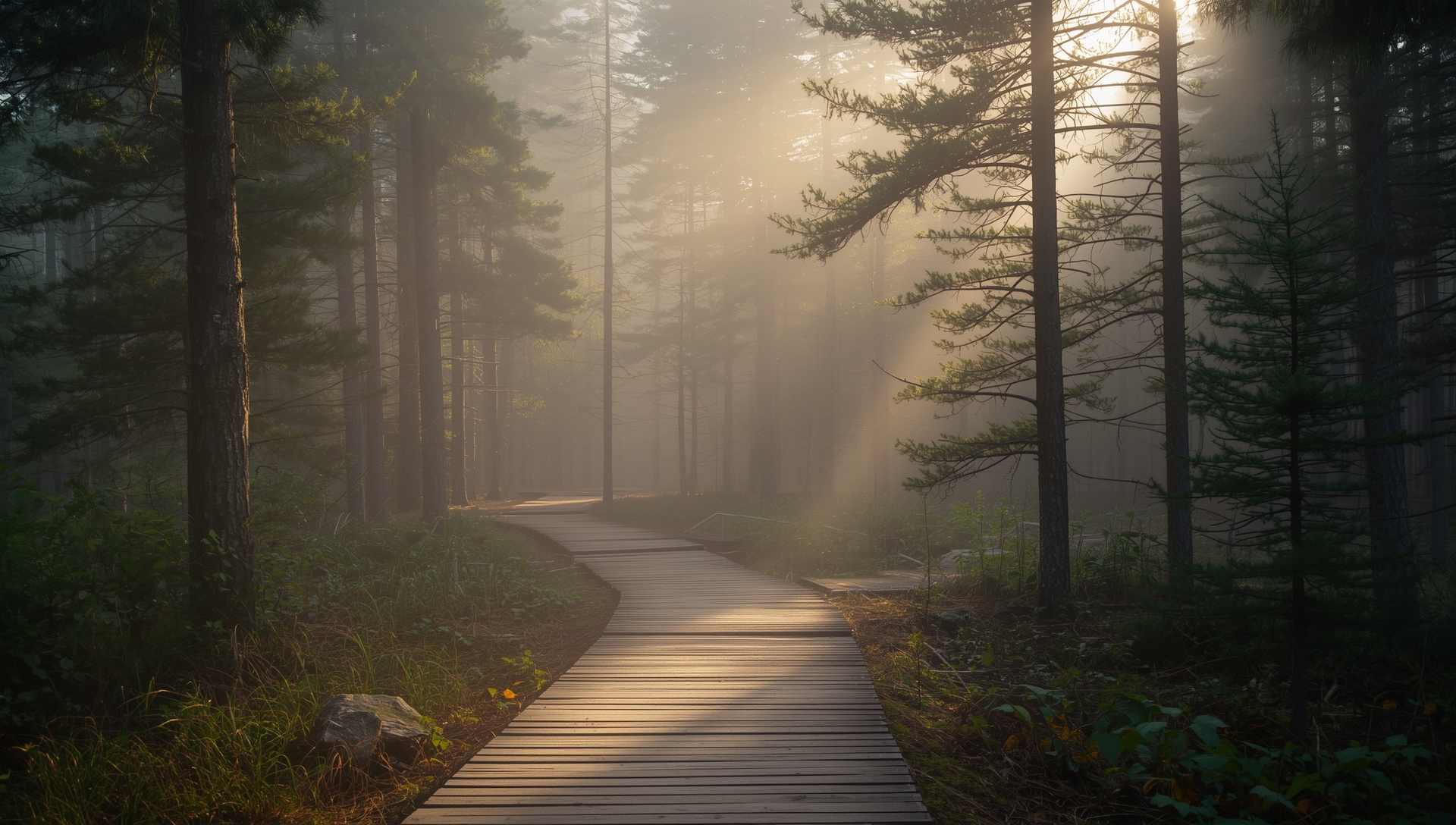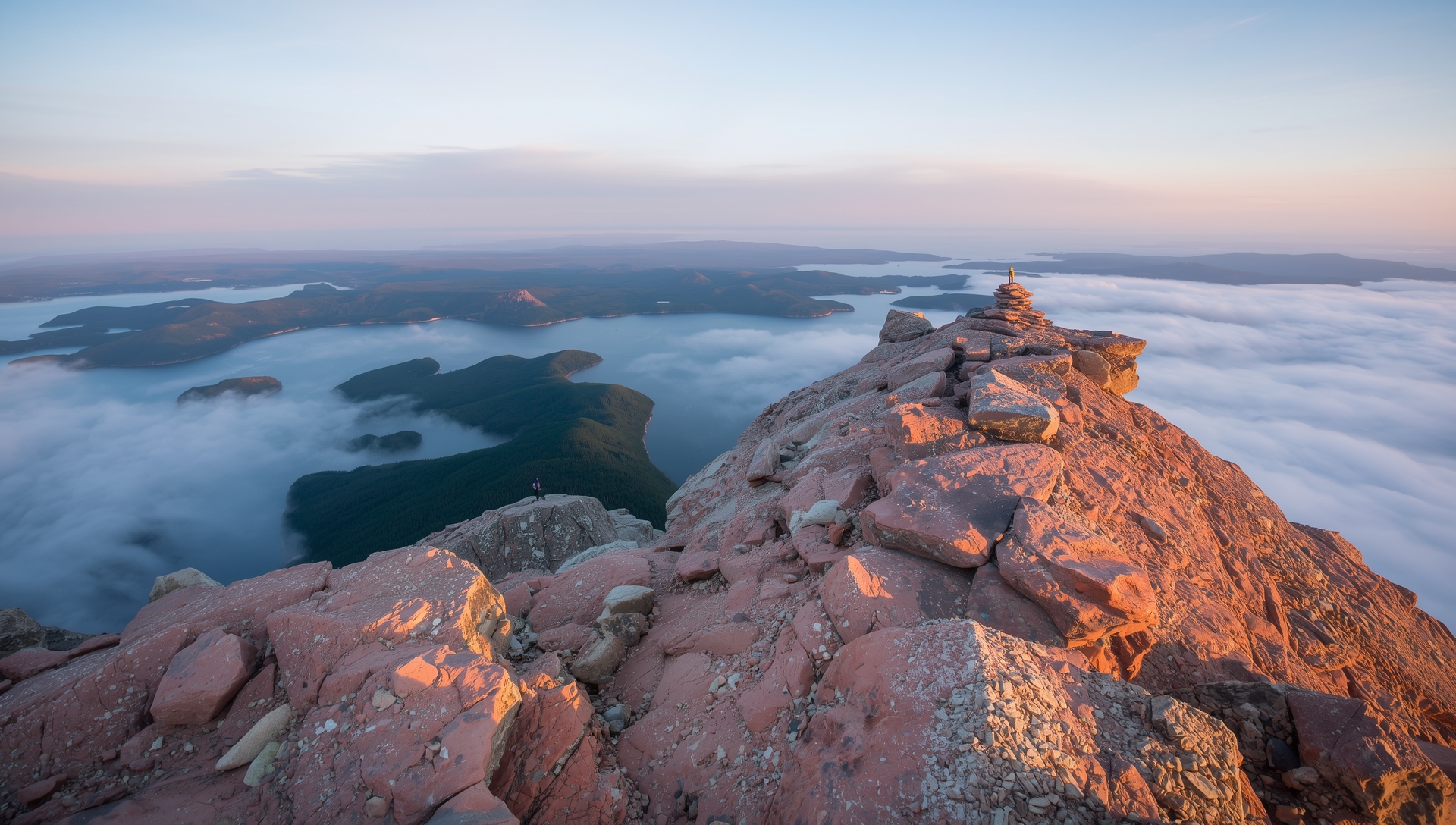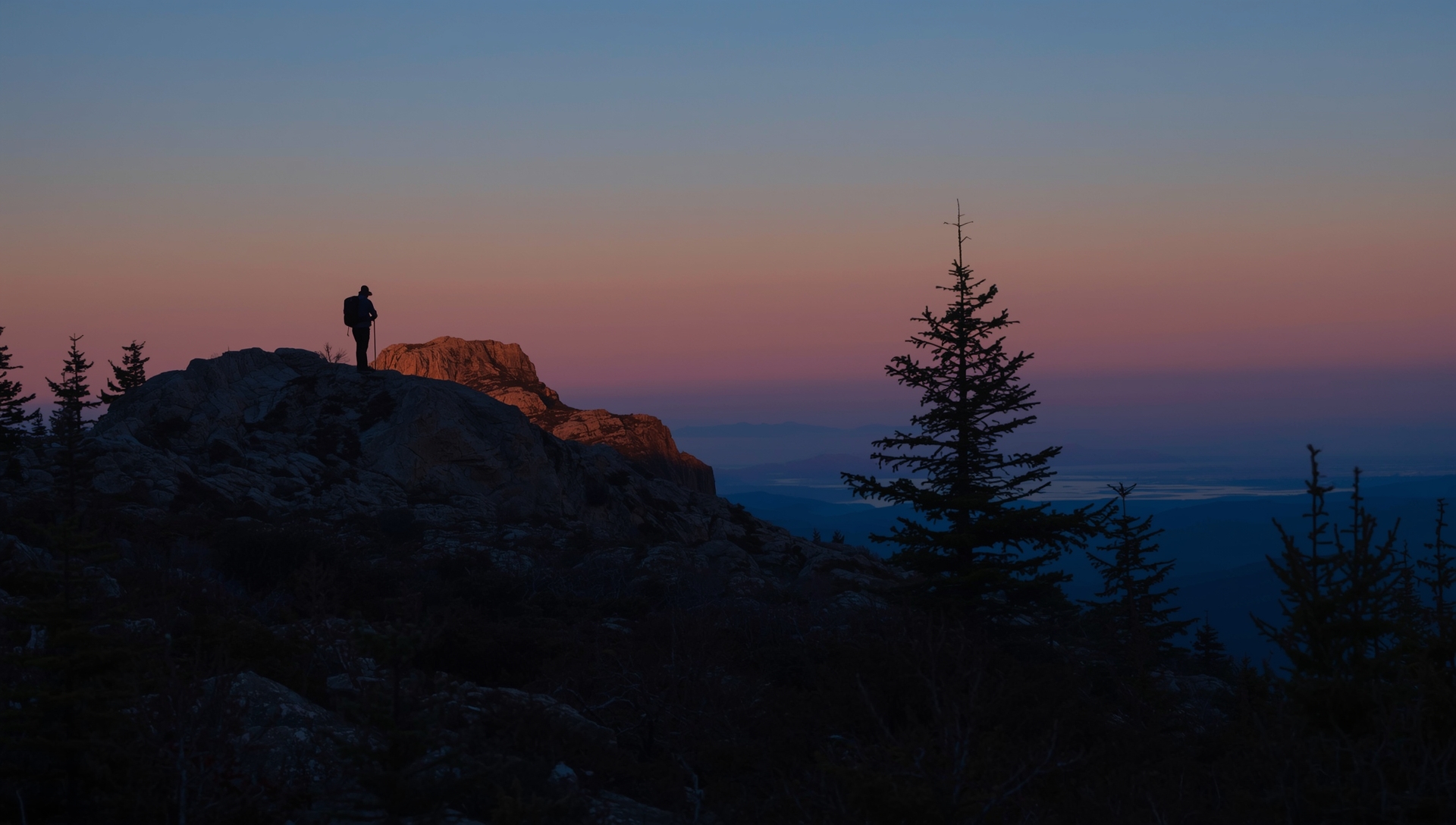Home › Acadia National Park › Trails in Acadia › Cadillac Mountain Trail
Cadillac Mountain Trail
Climbing Toward the First Light: Cadillac Mountain Trail
The Cadillac Mountain Trail begins in silence — only the faint stir of wind through spruce and the rhythmic sound of waves far below. Morning light catches on wet leaves, and each step upward feels like crossing a threshold between sea and sky. The granite underfoot, cracked and timeworn, glimmers with specks of quartz that sparkle in the dawn. This mountain has greeted the sun for centuries, and with every slow stride, hikers follow the same ritual — climbing toward the first light to touch America’s day before anyone else.
The lower forest feels intimate and alive. Moss covers the stones, pine needles scent the air, and fog moves through the trees in thin, drifting ribbons. The climb soon opens to broad granite shelves dotted with low-lying juniper and blueberry shrubs. A glance over your shoulder reveals Bar Harbor below, tiny and still, and beyond it, the Porcupine Islands glowing faintly in early light. The rhythm of the trail shifts as the forest thins; the world widens, and you begin to walk within the sky itself.
By the time you near the summit, the air sharpens. The Atlantic stretches in an unbroken sweep of blue, and shadows of seabirds cross the granite dome. The path winds past cairns built by generations of hikers who paused here, perhaps to watch the first rays break over Frenchman Bay. The scene is both vast and quiet — Acadia in its purest form. Whether you ascend by the North Ridge, the longer South Ridge, or join the short Cadillac Summit Loop Trail, the Cadillac Mountain Trail is more than a climb; it’s a meditation in motion. Here, stone, wind, and sunlight converge to create the moment that defines the park itself — the first light of Acadia.
- Peak Elevation: 1,530 ft (466 m) — highest summit on the U.S. Atlantic coast.
- Trail Length: 4–4.5 miles via North Ridge; 7 miles via South Ridge.
- Trail Type: Out-and-back or combined loop using ridge and summit connectors.
- Highlights: Granite ridges, wild blueberries, sweeping ocean panoramas, and sunrise views over Bar Harbor.
- Best Season: Late spring through fall — early mornings for sunrise, autumn for color and clear light.
- Linked Routes: Cadillac North Ridge Trail, Cadillac South Ridge Trail, Cadillac Summit Loop Trail.
- Trail Mood: Calm, expansive, and reflective — a journey through Acadia’s soul.
Trail Experience — Walking the Cadillac Mountain Trail Loop
The Cadillac Mountain Trail is the heart of Acadia — a living backbone that ties together the park’s most iconic ridges, viewpoints, and summit experiences. It isn’t just one trail, but a network of routes that meet on the mountain’s granite dome, where the land rises into the sky and the ocean fans out in every direction. Every route to the summit feels slightly different, but each offers that unmistakable Acadia combination of sea air, smooth granite, and endless horizon.
Most visitors begin along the Cadillac North Ridge Trail, a classic Acadia climb that follows a spine of exposed granite and low spruce from Park Loop Road to the summit. Cairns mark the way across open rock as the forest thins and Frenchman Bay appears like a watercolor below. On clear mornings, hikers can spot the Porcupine Islands shimmering in the haze and the town of Bar Harbor waking along the shoreline. This ridge is where the phrase hiking Cadillac Mountain truly comes alive — a slow, open ascent where the mountain and sea unfold together.
For those who prefer a longer and quieter approach, the Cadillac Mountain South Ridge Trail begins near Blackwoods Campground Acadia and winds through spruce forest and blueberry barrens before reaching the broad upper slopes. The terrain here feels ancient — smooth granite rippled by ice and sunlight, leading to some of the most sweeping views in the park. The South Ridge Trail also delivers striking glimpses of Otter Creek, the Atlantic Ocean, and the wooded ridges that shape Mount Desert Island’s southern coast.
Once at the summit, the Cadillac Mountain Summit Loop Trail offers a short but unforgettable circuit around the highest point on the U.S. Atlantic coast. It’s accessible to nearly everyone, with interpretive signs, well-marked stone paths, and breathtaking 360-degree views. From here, visitors can gaze east toward the sunrise over Frenchman Bay or west across the interior forests toward Jordan Pond and the Bubbles.
To the west, the Cadillac West Face Trail plunges sharply into forested ravines — a steep, challenging route favored by experienced hikers seeking solitude. It’s a place where Acadia’s rugged spirit shows itself fully: narrow ledges, moss-covered stones, and the sound of distant wind echoing off the granite walls. Nearby, the Cadillac Cliffs Trail twists through a maze of rock outcrops and boulder passages, connecting lower ridges and offering a sense of wild seclusion rarely found on the busier summit routes.
Every route eventually leads to the same reward — the Cadillac Mountain summit. Standing here at dawn, the world seems to pause. The Cadillac Mountain sunrise is legendary for good reason: for much of the year, this peak catches the first light to touch the United States. When fog blankets the bay, the sun appears to rise from a silver sea; on clear days, it sets the islands ablaze with gold. Whether you hiked one of the ridges, arrived via the Cadillac Mountain Road, or planned ahead with a sunrise reservation through Recreation.gov, that moment feels sacred — a meeting of light, land, and sea.
Maps, elevation guides, and Cadillac Mountain Trail information are posted at key trailheads and available through park rangers. However you reach the top, Cadillac rewards patience. Spend time on the granite, trace the cairns with your eyes, and watch the colors change minute by minute. Hiking Cadillac Mountain isn’t just a climb — it’s the story of Acadia told in stone and light.
- Cadillac North Ridge Trail — iconic granite ridge ascent with ocean panoramas.
- Cadillac South Ridge Trail — longer, scenic climb from Blackwoods Campground through forest and ridgeline.
- Cadillac Summit Loop Trail — short, accessible circuit offering 360° views of Acadia and Frenchman Bay.
- Cadillac West Face Trail — steep, rugged descent for experienced hikers seeking solitude.
- Cadillac Cliffs Trail — dramatic granite corridor linking lower ridges and forest paths.
Other key mentions: Cadillac Mountain Road (drive-up access), Cadillac Mountain Sunrise Reservations (via Recreation.gov), and Cadillac Mountain Map for route planning.
Trail Facts — Cadillac Mountain Trail Acadia
The Cadillac Mountain Trail is more than a climb — it’s a complete summit experience, blending rugged hiking with accessible routes that make the peak a year-round favorite. Standing 1,530 feet (466 m) above sea level, Cadillac Mountain offers the highest vantage on the North Atlantic coast, and its network of loops, connectors, and overlooks gives every visitor a way to reach the same extraordinary view.
At the heart of it all is the Cadillac Mountain Summit Loop, a short 0.3-mile (0.5 km) circuit that circles the granite dome. The path is wide, mostly paved, and dotted with interpretive signs explaining the mountain’s geology, ecology, and cultural history. Despite its ease, the loop delivers a spectacular 360-degree panorama over Frenchman Bay, the Porcupine Islands, and the forested ridges of Mount Desert Island. The summit’s layered granite turns pink and gold under changing light, giving photographers and painters a palette that evolves by the minute.
For those driving, the Cadillac Mountain Summit Road winds 3.5 miles (5.6 km) from the Park Loop Road to the top, climbing gently through spruce forest and open rock. Each curve reveals a new outlook — notably Blue Hill Overlook Acadia, one of the best spots to witness first light in America. Because traffic to the summit is heavily managed, visitors need a vehicle reservation (or day pass) through Recreation.gov from late May to mid-October. These limited permits help reduce congestion and protect fragile summit vegetation.
At dawn, the Sunrise Trail — a short connector linking the upper parking area to the first viewpoint eastward — fills with early risers wrapped in blankets and hope for clear skies. This unofficial spur isn’t long, but it’s steep enough to raise the heart rate before the reward: a horizon of glowing orange and mist lifting over the islands. For those chasing sunset instead, the West Overlook provides a mirror experience, turning the ocean silver beneath fading light.
Several connectors loop from the Summit Road pullouts back into the main loop trail, allowing visitors to mix short strolls with overlook stops. These mini-trails are perfect for families or photographers who prefer flexibility over full hikes. Because weather on Cadillac Mountain can shift in minutes — fog rolling in from the sea, winds gusting suddenly — it’s wise to pack a jacket and check conditions before heading up.
The mountain’s surface is a mix of crushed gravel and pink-granite slab, often slick with morning dew. Low-tread shoes struggle here; sturdy hiking footwear provides better grip. Railings protect most drop-offs, but stepping off trail damages the thin alpine soil and lichen that anchor this unique summit ecosystem. Rangers remind visitors that even small footsteps beyond the path leave lasting marks in a landscape that takes decades to heal.
Accessibility and safety are both priorities on Cadillac. The paved loop accommodates strollers and wheelchairs for much of its length, restrooms operate seasonally, and a gift shop and information station open daily during summer. The Island Explorer Shuttle Acadia runs frequent loops to the lower Park Loop Road, offering a car-free way to reach or depart the mountain when parking fills.
From sunrise to starlight, Cadillac Mountain balances wildness and welcome — a peak anyone can reach, but few ever forget.
- Elevation: 1,530 ft (466 m) — highest point on the U.S. Atlantic coast.
- Summit Loop Length: 0.3 mi (0.5 km); easy grade, partly paved.
- Access Routes: Summit Road (3.5 mi drive), Sunrise Trail (connector path), Overlooks (Blue Hill and West View points).
- Vehicle Reservation: Required May–Oct for summit parking and sunrise access.
- Surface & Conditions: Granite slabs and fine gravel; avoid slick sections in fog or rain.
- Facilities: Seasonal restrooms, visitor information, gift shop at summit.
- Shuttle Option: Island Explorer (Route 3) connects trailheads and loop road pullouts.
- Best Viewing Times: Sunrise over Frenchman Bay or sunset toward Blue Hill Bay.
Trail Highlights & Nearby Spots — Cadillac Mountain Trail Acadia
The beauty of the Cadillac Mountain Trail lies not only in its summit but in the intricate web of smaller paths that unfold around it. Every spur and connector adds a new angle to the story — a different rhythm of wind, color, and sound. Together they form a living map of Acadia’s geology and spirit: granite ridges shaped by ice, brooks carved by rain, and views that stretch from forest floor to open sea. Exploring them reveals how Cadillac is not one trail but a network of experiences, each tuned to a different part of the mountain’s soul.
From the South Ridge Trail, a brief South Ridge Connector leads to the quiet Eagle Crag Spur, one of the most tranquil outlooks on Mount Desert Island. Few hikers take this turn, and its silence is its charm. The ledges are brushed with low blueberry, crowberry, and alpine grasses that shimmer red and bronze in late summer light. From the edge, the Atlantic glitters far below, Otter Creek winds through forest to the sea, and you can sense how the ocean’s slow rhythm has sculpted the island over centuries. It is an intimate perch — wind in your hair, gulls rising on the thermals — that reminds you why Cadillac Mountain has always felt both vast and personal.
Below these southern ridges, the Canon Brook Trail follows a shaded corridor where water slips over smooth pink granite, collecting in pools lined with moss and fern. The air is cool and heavy with the scent of spruce. Shafts of sunlight break through the canopy, turning the brook silver for a heartbeat before fading again into shadow. For those craving adventure, Canon Brook joins the base of the Gorge Path, one of Acadia’s most dramatic climbs. The gorge funnels wind through steep stone walls; cairns mark the way between boulders slick with lichen. Here, the mountain feels ancient — shaped by glaciers, echoed by the cry of ravens that circle high overhead.
To the north, Kebo Brook Trail provides a gentler close to the mountain’s drama. It traces the small stream that carved these lower slopes, flowing quietly toward Bar Harbor. Early morning mist curls above the water, and reflections of birch and spruce tremble across its surface. Many hikers follow this route back to town after summiting Cadillac Mountain, letting the forest soften the transition from wilderness to village. The gradual descent and even footing make it ideal for families, photographers, and anyone ready to savor Acadia at an easier pace.
Taken together, these connecting trails show that Cadillac Mountain is more than a climb; it’s a landscape to wander. Some paths lead into stillness, others into wind and sky, but all eventually converge on the same granite crown. Whether you hike them separately or weave them into a single circuit, they reveal the living rhythm of Acadia — a mountain breathing through forest, water, and stone, inviting discovery in every direction.
• Eagle Crag Spur: Quiet overlook off the South Ridge Trail with sweeping Atlantic views.
• South Ridge Connector: Links Blackwoods Campground to Eagle Crag Spur for a peaceful detour.
• Canon Brook Trail: Shaded granite corridor with cascades and mossy ravines.
• Gorge Path: Steep, dramatic climb through boulder fields to Cadillac’s western slopes.
• Kebo Brook Trail: Gentle stream-side route leading toward Bar Harbor and the Park Loop Road.
• Tip: Combine multiple connectors for a loop revealing Cadillac Mountain’s diverse terrain in a single day.
Nature & Wildlife Along the Cadillac Mountain Trail
Life clings to the granite of Cadillac Mountain in ways that surprise almost everyone who hikes it. What first appears as bare stone quickly reveals a living tapestry of color, texture, and motion. Wind, frost, and salt shape every surface, and within those shallow cracks grow entire communities of plants and animals uniquely adapted to survive the extremes of the highest point on the Atlantic coast. To walk the Cadillac Mountain Trail is to see how nature endures, adjusts, and thrives on the edge of sea and sky.
At the base, the world feels lush and sheltered. Spruce, fir, and white birch stand tall, their roots weaving through thin soil above the granite bedrock. Sunlight filters through the canopy, glinting off wet bark and dripping moss after morning fog. Here, along the gentle boardwalk of Jesup Path, birdcalls echo through the Hemlock Forest. The Hemlock Path, running parallel through wetlands near Bar Harbor, hosts red-backed salamanders, wood frogs, and tiny warblers feeding in the cool shade. These lowland paths form a living threshold to the climb ahead — a green world that transitions steadily toward open granite and wind.
As elevation increases, trees twist into bonsai-like forms. Coastal wind scours the ridges, and branches bend permanently eastward. Patches of reindeer lichen, alpine blueberry, and crowberry take the place of tall forest, carpeting the stone in silver, green, and deep red. By midsummer, bees hum between the low blossoms while monarchs drift overhead, carried by warm updrafts that rise from Frenchman Bay. Each plant and insect here works within razor-thin margins of survival — frozen in winter, sun-baked in July, yet essential to holding the fragile summit soil together.
Wildlife shifts as you climb. The call of a black-capped chickadee near the lower forest gives way to the whistle of wind across the ledges. Gulls circle effortlessly on thermals from the ocean below, while peregrine falcons patrol the western cliffs above the West Face Trail. On calm mornings, you might spot a snowshoe hare darting between granite outcrops or a red fox cutting across the open heath in search of mice. Every creature is finely tuned to this place — shaped by weather as much as by instinct.
Reaching the summit feels like stepping into a different ecosystem altogether. The lichen-covered granite glows pink in dawn light, then blazes gold at sunset. Moisture from fog nourishes the lichens, and temperature drops can shift within minutes as clouds roll in from the bay. From here, hikers witness the first sunrise in the United States, an event that ties together life, light, and motion. The sight of the sun breaking the horizon isn’t just scenic; it’s ecological — the same rays that paint the rock also feed the photosynthetic crusts clinging to its surface. Even the air feels alive, thick with salt and pollen, carrying the faint cries of seabirds below.
To walk Cadillac Mountain from Jesup Path to summit is to trace Acadia’s entire ecological story in a single day — from shaded forest to alpine ridge, from croaking frogs to gliding falcons. It’s not only a hike but a lesson in resilience, written in moss, lichen, and light.
• Vegetation: Reindeer lichen, alpine blueberry, and crowberry thrive in thin summit soils.
• Wildlife: Peregrine falcons, herring gulls, snowshoe hares, and migrating monarchs frequent the ridge.
• Lower Ecosystems: Jesup Path and Hemlock Path feature shaded hemlock groves and wetland habitats near Bar Harbor.
• Elevation Transition: Dense coastal forest gives way to open granite and low alpine heath.
• Tip: Visit at dawn or dusk for seabird activity and the shifting colors of the Cadillac Mountain summit.
Seasons on the Cadillac Mountain Trail
No matter when you climb it, Cadillac Mountain feels alive with change. The trail’s mood shifts with each season — light, color, and weather transforming the same granite into four distinct experiences. From the misty quiet of spring to the crisp blaze of autumn, every visit reveals a new rhythm between land and sky.
- Acadia in Spring – Reawakening the Mountain
By late April, snow recedes from the ridges, and streams along Canon Brook Trail and Kebo Brook Trail begin to sing again. Fresh moss spreads across boulders, and the first wildflowers — bluebead lily, bunchberry, and trailing arbutus — push through the thaw. Days are cool, trails damp, and fog often clings to the lower forest, giving the mountain a dreamlike stillness. Early mornings may bring frost, but also the clearest sunrises of the year. Watch the first light over Frenchman Bay from Blue Hill Overlook, where the air feels newly washed and the landscape glows with renewal.Summer – Life in Full Light
Acadia National Park in summer brings long daylight, salt-scented breezes, and the steady hum of hikers on the Cadillac Mountain Trail. The summit’s pink granite bakes under sun, yet a light wind keeps it pleasant even on warm days. Alpine blueberries ripen in mid-July, turning the slopes into natural snack bars for birds and wanderers alike. This is the best season to link the Summit Overlook Connectors, short spur paths that circle the crown and lead to views in every direction. Late afternoons invite rest on sun-warmed rock while gulls and falcons trace the sky above. Evening descents offer lingering gold across Frenchman Bay — a slower, quieter end to a bright day.
- Acadia in the fall – Color and Clarity
From late September to mid-October, the mountain becomes a mosaic of amber, scarlet, and deep green. The forest below glows, mirrored in the granite pools near Eagle Crag Spur. Cool, dry air sharpens every detail — the scent of pine, the crunch of lichen underfoot, and the clarity of distant islands. Sunrise arrives later, giving visitors more time to reach the summit before the first light. Autumn’s balance of crisp weather and vivid color makes it the best season to visit Cadillac Mountain for both photographers and hikers seeking calm.
- Acadia National Park Winter – The Silent Summit
Winter transforms Cadillac into solitude. Snow dusts the ridges, and wind scours the granite bare again. Access roads may close, but hardy trekkers who ascend from the South Ridge Trail find a world of silver and silence. On clear days, the low sun lights the Atlantic like glass. Even when temperatures fall below freezing, lichen continues to survive — a quiet symbol of endurance in Acadia’s harshest months.
Each season writes its own chapter in Cadillac’s story. Weather changes quickly here — fog can roll in within minutes, hiding the sea, then vanish as sunlight floods the rocks. Whether you come for the Cadillac Mountain sunrise, the burnished colors of sunset, or the simple peace of snow, you’ll find that no two days on this mountain are ever the same.
• Best Season: Late September to mid-October for color and clarity.
• Spring: Melting snow, blooming forest, clear morning sunrises.
• Summer: Warm days, active wildlife, open Summit Overlook Connectors.
• Autumn: Crisp air, vibrant foliage, ideal photography light.
• Winter: Quiet summit, icy views, solitude for experienced hikers.
• Tip: Always check Cadillac Mountain weather before you go — conditions change fast at the summit.
Planning Your Visit to Cadillac Mountain
Cadillac Mountain is one of those places where timing, preparation, and planning turn a good trip into an unforgettable experience. Because it’s the most visited peak in Acadia National Park, a little knowledge about permits, shuttles, and routes goes a long way toward ensuring a smooth ascent. Whether you drive the Cadillac Mountain Summit Road or take one of the mountain’s hiking routes, understanding how access works will help you make the most of every sunrise and summit stop.
- Reservations and Permits
During the busy season — typically late May through mid-October — visitors must obtain a Cadillac Mountain reservation through Recreation.gov. The system helps limit congestion and protect the fragile summit vegetation. There are two types of entry windows: one for sunrise reservations, and another for daytime access. Sunrise spots fill within minutes, so plan ahead; cancellations do appear, so checking the site regularly often pays off. Each reservation corresponds to one vehicle pass, and the driver must also hold a valid Acadia National Park entrance pass.
Those arriving without a car can still experience the summit by using the Island Explorer Shuttle, a free and eco-friendly option that connects Bar Harbor to multiple stops along the Park Loop Road. The shuttle runs frequently between late June and early October and allows riders to disembark near the Summit Road gate or the North Ridge Trailhead.
- Driving and Parking on the Summit Road
The Cadillac Mountain Summit Road climbs 3.5 miles (5.6 km) from the Park Loop Road to the top. Each curve opens a new panorama over Frenchman Bay and the Porcupine Islands. Traffic is one-way uphill, and posted limits are strictly enforced. Parking areas are small, so early arrival matters — especially for sunrise. Even after daylight, lots fill quickly between 9 am and 2 pm, when tour buses and rental cars peak. Those planning photography stops should allow time to pull into the Blue Hill Overlook or one of the smaller Summit Overlook Connectors before looping back down.
- Hiking Alternatives and Adjacent Routes
Visitors looking to skip vehicle reservations can ascend by foot via the Cadillac North Ridge Trail or South Ridge Trail — both open year-round without permits. Adventurous hikers can extend their route by connecting to the Dorr Mountain South Ridge Trail or the more challenging Giant Slide Trail, each offering secluded views away from the main summit. These nearby trails link naturally into Acadia’s interior and are ideal for those seeking quieter experiences.
- On-Site Facilities and Tips
At the summit, you’ll find a small gift shop, seasonal restrooms, and interpretive displays explaining Cadillac’s geology and history. Rangers are often available to answer questions about Cadillac Mountain tours, weather conditions, or reservation tips. Because summit weather can shift in minutes — fog, wind, and sudden chill — carry layers even in summer. There are no food services on the mountain, so pack water and snacks.
Even if you miss a reservation window, the Cadillac Mountain Sunset hour rewards patience. Arrive in the late afternoon to watch colors drift from gold to lavender over the bay. Between shuttle convenience, flexible hiking routes, and thoughtful planning, every visitor can find a path to the same unforgettable view — the Cadillac Mountain summit experience that defines Acadia.
• Reservations: Required May–October via Recreation.gov for sunrise and daytime visits.
• Summit Road: 3.5-mile drive from Park Loop Road with limited parking at top.
• Shuttle Service: Island Explorer bus connects Bar Harbor and Cadillac Mountain trailheads.
• Alternative Hikes: North Ridge and South Ridge Trails require no vehicle permit.
• Nearby Extensions: Link to Dorr Mountain South Ridge Trail or Giant Slide Trail for longer routes.
• Facilities: Gift shop, restrooms, and interpretive signs available seasonally.
• Tip: Check Cadillac Mountain weather before you go — fog and wind can arrive within minutes.
Nearby Trails Around Cadillac Mountain
While the Cadillac Mountain Trail commands attention, a web of nearby paths expands the experience far beyond the summit. Each one offers its own rhythm and view — from mossy forests to cliffside overlooks — giving hikers a deeper sense of Acadia’s wild terrain. Linking these Cadillac-adjacent trails together creates days of exploration that feel both varied and connected, whether you begin in Bar Harbor or along the quiet southern coast of Mount Desert Island.
To the north and west, the Gorge Path and Kebo Brook Trail create natural gateways to Cadillac. The Gorge Path rises steeply between Cadillac and Dorr Mountains, tracing a rocky, tree-lined ravine that feels almost alpine. Water trickles through moss and roots, cooling the air even on warm days. Hikers can combine it with the Kebo Brook Trail — a gentler route lined with birch and spruce — to form a scenic ascent that gradually meets the North Ridge Trail. Together, they make a rewarding loop for those seeking a forest-to-summit experience.
Just east of Cadillac, the Canon Brook Trail and Eagle Crag Spur lead into more secluded corners of Acadia. The Canon Brook Trail starts near the Park Loop Road and follows its namesake brook, crossing polished granite slabs and glacial erratics before joining the South Ridge. The Eagle Crag Spur, meanwhile, branches off toward rocky bluffs that look down over the forest canopy — a photographer’s favorite during the fall color peak. From here, it’s possible to reconnect with the Cadillac South Ridge Trail or descend toward Otter Creek, making it a versatile route for experienced hikers.
To the south, Dorr Mountain’s South Ridge Trail provides one of the best companion hikes to Cadillac itself. The two peaks share similar geology, but Dorr offers a quieter, less-traveled summit. The trail rolls across granite ledges painted with lichen and wild blueberry bushes, eventually revealing views across the valley toward Cadillac’s broad back. Linking Dorr’s trails with Cadillac’s network gives visitors a true feel for Acadia’s heart — where stone, forest, and sky meet seamlessly.
Another nearby favorite, the Giant Slide Trail, climbs through a narrow gorge of towering boulders and ferns before connecting with the Dorr network. It’s a cool, shaded contrast to Cadillac’s open granite slopes — an excellent pairing for those seeking variety.
Closer to Bar Harbor, the Jesup Path and Hemlock Path offer a gentler way to experience Acadia’s ecosystems. These boardwalk-style paths pass through wetlands and hemlock stands near the Wild Gardens of Acadia, where interpretive signs highlight the park’s flora. Though far tamer than Cadillac’s upper ridges, these short walks are the perfect prelude or cooldown for any mountain hike.
Together, these trails form the Cadillac Mountain corridor — a collection of routes that reward both casual explorers and seasoned hikers. They blend challenge, beauty, and connection, turning a single summit into a network of Acadia memories.Each of these trails tells a different part of Acadia’s story — some rise straight from the sea, others meander through forested hollows, and a few wind quietly toward viewpoints few visitors ever see. Linking them all together forms an invisible web around Cadillac Mountain, connecting summits, cliffs, and shorelines into one remarkable hiking system. Whether you follow the cairns to the sky or stroll beneath hemlocks and moss, every path adds its own verse to Acadia’s ongoing song of stone and light.
- Cadillac North Ridge Trail – classic granite ridge with open views of Frenchman Bay.
- Cadillac South Ridge Trail – long scenic ascent through spruce and blueberry barrens.
- Cadillac Summit Loop Trail – short accessible loop with 360° views from Acadia’s highest point.
- Cadillac West Face Trail – steep, rugged descent into moss-covered ravines and ledges.
- Cadillac Cliffs Trail – twisting route through boulders and rocky outcrops near the lower ridge.
- Eagle Crag Spur – side path to dramatic cliff views above the forest canopy.
- South Ridge Connector – joins Cadillac’s main ridge to interior forest trails.
- Canon Brook Trail – follows a clear brook with glacial boulders and shaded crossings.
- Kebo Brook Trail – gentle forested path linking Bar Harbor to the North Ridge.
- Gorge Path – steep, scenic ravine climb between Dorr and Cadillac Mountains.
- Cadillac Mountain Summit Road – 3.5-mile scenic drive to Acadia’s summit.
- Blue Hill Overlook – best spot for sunrise and panoramic photo stops.
- Cadillac Sunrise Spur – short climb from summit parking to first-light viewpoint.
- Summit Overlook Connectors – looped walkways joining multiple summit vistas.
- Dorr Mountain South Ridge Trail – quieter twin summit with sweeping ocean views.
- Giant Slide Trail – shaded canyon route with massive glacial boulders.
- Jesup Path – easy boardwalk through wetlands and birch forest near Bar Harbor.
- Hemlock Path – cool, shaded woodland trail connecting to Jesup Path.
Reflect & Explore More — Cadillac Mountain Trail Acadia
The Cadillac Mountain Trail captures the essence of Acadia National Park — where ocean, forest, and granite rise together to greet the first light in the United States. Whether you hiked up the North Ridge, explored the quieter South Ridge, looped around the summit, or simply drove the winding Summit Road, every route leads to the same breathtaking conclusion: standing atop the highest peak on the Atlantic coast. From this point, the views extend over Frenchman Bay, Bar Harbor, and the Porcupine Islands, reminding visitors how Acadia’s landscapes connect — ridge to shore, forest to sea.
Those who linger at the top see how quickly the light transforms Cadillac’s granite crown. Morning haze turns to crisp daylight; the afternoon sun ignites the cliffs in warm tones of rose and gold. As evening approaches, the same paths that glowed at dawn fade gently into the soft colors of sunset, while the wind carries the scent of pine and salt air. Each visit feels different, each climb unforgettable.
Before leaving the mountain, visitors can extend their experience along Acadia’s other trails — the Gorge Path linking Cadillac to Dorr Mountain, or the Jesup Path and Hemlock Path, weaving through lowland forests toward Sieur de Monts. These short walks invite a slower rhythm, encouraging hikers to notice Acadia’s delicate details — the moss-covered stones, the whisper of the forest, and the quiet that settles after sunrise. Whether you came for adventure, photography, or reflection, Cadillac Mountain Trail rewards every kind of traveler with something timeless: perspective.
- Dorr Mountain South Ridge Trail – A forested ridge walk connecting to the Gorge Path.
- Giant Slide Trail – Hidden waterfalls and mossy boulders beneath Cadillac’s western slopes.
- Jesup Path & Hemlock Path – A quiet loop through birch and hemlock near Sieur de Monts.
- Bar Harbor – Coastal charm, dining, and the gateway to your next Acadia hike.
From the granite heights of Cadillac to the stillness of the forest floor, Acadia National Park invites you to explore, reflect, and return.
Every trail on Cadillac Mountain tells a part of Acadia’s story — from sunrise climbs to forest walks, each path reveals a new way to see the park. Whether you’re planning your next summit or a quiet stroll beneath the pines, Acadia’s trails are ready to explore.
Explore Trails in Acadia National ParkLearn more about Cadillac Mountain and Acadia National Park from trusted sources and explore deeper trail guides and inspiration.
Love Acadia’s trails and stories? Stay inspired with our latest park guides, trail updates, and insider tips delivered straight to your inbox. Be the first to know what’s new across America’s national parks.
Sign Up